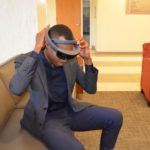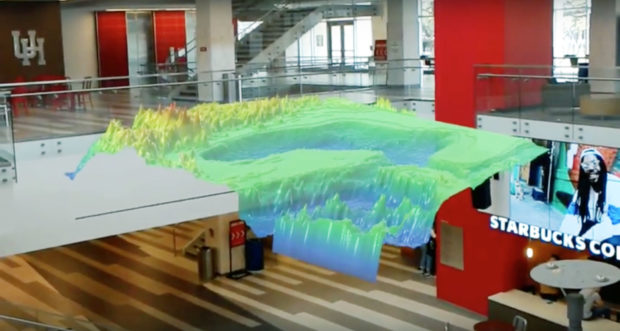

James can manipulate the size and position of a hologram — in this case, a three-dimensional topographic map. | Courtesy of Evan James
Wearing a bulky version of La Forge’s visor from “Star Trek,” a man pinches and pulls the air in front of him; behind the lens of his futuristic goggles, reality is altered.
University of Houston mechanical engineering senior Evan James is developing software for a device that creates an immersive augmented reality experience. The Microsoft HoloLens can be used to aid engineers in visualizing and interacting with their ideas in three-dimensional space.
“HoloLens is the true and most superior first-generation mixed-reality device that projects for a user a layer of relevant information on top of the physical objects or environment,” said computer science research assistant professor Chang H. Yun.
The technology enables the wearer to see holographic versions of objects or people and view them from all angles as if they were in the same room.
“As a mechanical engineer, it’s all about developing technology that can help our work process,” James said. “So, what I’ve built is a holographic topographical map of the Gulf of Mexico to visualize where the oil pockets are.”
James is no stranger to getting creative with technology; his creative insights were recognized after making it to the finals in the U.S. Microsoft Imagine Cup 2015. Windows Insiders, a select group of developers given the first opportunity to experiment with new Microsoft technology, invited James to be a member.
Once approved, James received a developer edition of the Microsoft HoloLens in order to begin designing applications to see the technological world in a whole new dimension.
Though James uses the wearable computer to generate three-dimensional models of the ocean floor, he says the applications of this technology are limitless.
“Right now, the field is taking off,” said second-year doctorate student Daniel Biediger, who researches augmented reality for visualization, education, simulation and training. “There are many projects that involve construction, planning, medicine, data visualization and even games. It’s much more natural to interact with higher-dimensional data in higher dimensions.”
James said the HoloLens could prove to be useful in providing a three-dimensional full-size blueprint, which contractors could build on top of to ensure precision construction. Holograms could help medical students understand how the human body works by zooming in on specific organs to observe their function.
The technology could even host a game that scans the room and layers virtual walls and objects on top of the real world to create an immersive augmented-reality video game.
Virtual holograms could also revolutionize the way people live their daily lives.
“Unlike watching TV, which requires you to sit or stand in front of the device, or talking on the phone, which requires you to hold the device to your ear, this technology requires no specific posture,” said James. “Your hands are completely free and you’re not required to sit down; you can look at the data while you’re working on something else.”
James imagines a world where someone wearing a HoloLens, which is controlled either by in-air hand motions or voice commands, can pull up the user manual while they’re fixing their car, or have a recipe from a cookbook in their field of vision while they’re trying to prepare a new meal.
With his military background, James envisions a future in which he can communicate with his loved ones while overseas via ‘holoportation’. By fitting a room with special cameras, he would be able to see the holographic form of his mother and children using the HoloLens as a viewing device.
While they haven’t had any takers in the big oil world, they have piqued the interest of a drill bit company. In the meantime, James develops other apps that utilize this holographic capability. In the not-so-distant future, mixed reality could become a part of the everyday experience for the American household, Yun said.
“You can make a lot of stuff with this technology,” James said. “It’s the imagination that comes first. Everybody who created something started with a great imagination.”
news@thedailycougar.com
—
“Senior’s hologram software could be used to augment reality” was originally posted on The Daily Cougar
